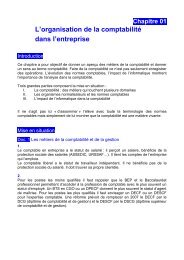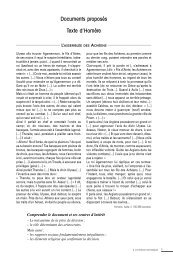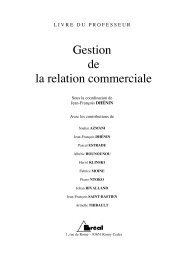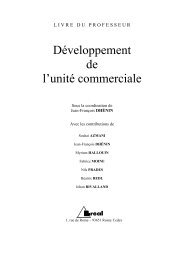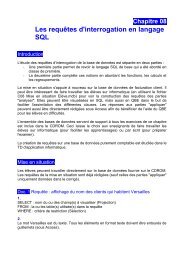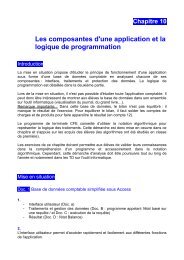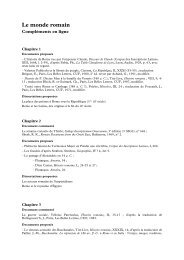correction exercices Précis de Physique-Chimie chapitre 5 à 9
correction exercices Précis de Physique-Chimie chapitre 5 à 9
correction exercices Précis de Physique-Chimie chapitre 5 à 9
You also want an ePaper? Increase the reach of your titles
YUMPU automatically turns print PDFs into web optimized ePapers that Google loves.
Exercices et extraits d’annales<br />
Exercice 6 : Extrait du BTS Cira 1994<br />
1. Voir §2.4.1 <strong>de</strong> ce <strong>chapitre</strong>.<br />
2. La formule du §1.4 du <strong>chapitre</strong> 10 (également présente dans les données <strong>de</strong> l’exercice) permet <strong>de</strong> calculer la<br />
3.<br />
4.<br />
masse molaire recherchée :<br />
M = 56 g.mol<br />
Alcène<br />
-1<br />
La masse molaire <strong>de</strong>s alcènes peut s’exprimer en fonction du nombre n d’atome <strong>de</strong> carbone présents dans cette<br />
molécule (voir question 3 <strong>de</strong> l’exercice 7 du <strong>chapitre</strong> 2). On peut ainsi en déduire n puis la formule brute <strong>de</strong><br />
l’alcène recherché : C4H<br />
8<br />
H<br />
H<br />
Priv<br />
C<br />
H<br />
Priv<br />
H<br />
H<br />
H<br />
H<br />
H<br />
Priv<br />
H<br />
Priv<br />
C<br />
C<br />
H<br />
Priv<br />
C<br />
H<br />
H<br />
Priv<br />
H<br />
Priv<br />
C<br />
H<br />
Priv<br />
C<br />
H<br />
Priv<br />
C<br />
H<br />
Priv<br />
C<br />
H<br />
Priv<br />
H<br />
Priv<br />
H<br />
Priv<br />
H<br />
Priv<br />
H<br />
Priv<br />
C<br />
C<br />
H<br />
Priv<br />
C<br />
H<br />
Priv<br />
C<br />
H<br />
(E)-but-2-ène (Z)-but-2-ène but-1-ène<br />
Remarque : un autre isomère est possible, il s‘agit du méthylpropène :<br />
H<br />
H<br />
C<br />
H<br />
Priv<br />
C<br />
C<br />
H<br />
Priv<br />
H<br />
Priv<br />
H<br />
Priv<br />
C<br />
H<br />
Priv<br />
H<br />
Priv<br />
5. C H + Cl = C H Cl<br />
4 8 2 4 8 2<br />
En partant <strong>de</strong> l’un <strong>de</strong>s <strong>de</strong>ux diastéréo-isomères du but-2-ène on obtient le 2,3-dichlorobutane.<br />
En partant du but-1-ène on obtient le 1,2-dichlorobutane.<br />
Exercice 7 : Extrait du BTS Travaux Publics 1996<br />
1.<br />
1.1. Ces <strong>de</strong>ux molécules font partie <strong>de</strong> la famille <strong>de</strong>s hydrocarbures. Pour leurs noms systématiques voir §2.3.1<br />
<strong>de</strong> ce <strong>chapitre</strong>.<br />
Eléments <strong>de</strong> <strong>correction</strong> <strong>de</strong>s <strong>exercices</strong> du <strong>chapitre</strong> 7 : chimie organique ; synthèse <strong>de</strong> polymères ■ 51



